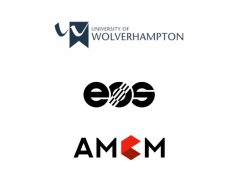Flexible electronics have enabled the design of sensors, actuators, microfluidics and electronics on flexible, conformal and/or stretchable sublayers for wearable, implantable or ingestible applications. However, these devices have very different mechanical and biological properties when compared to human tissue and thus cannot be integrated with the human body.
A team of researchers at Texas A&M University has developed a new class of biomaterial inks that mimic native characteristics of highly conductive human tissue, much like skin, which are essential for the ink to be used in 3D printing.
This biomaterial ink leverages a new class of 2D nanomaterials known as molybdenum disulfide (MoS2). The thin-layered structure of MoS2 contains defect centers to make it chemically active and, combined with modified gelatin to obtain a flexible hydrogel, comparable to the structure of Jell-O.
“The impact of this work is far-reaching in 3D printing,” said Akhilesh Gaharwar, associate professor in the Department of Biomedical Engineering and Presidential Impact Fellow. “This newly designed hydrogel ink is highly biocompatible and electrically conductive, paving the way for the next generation of wearable and implantable bioelectronics.”
This study was recently published in ACS Nano.
The ink has shear-thinning properties that decrease in viscosity as force increases, so it is solid inside the tube but flows more like a liquid when squeezed, similar to ketchup or toothpaste. The team incorporated these electrically conductive nanomaterials within a modified gelatin to make a hydrogel ink with characteristics that are essential for designing ink conducive to 3D printing.
“These 3D-printed devices are extremely elastomeric and can be compressed, bent or twisted without breaking,” said Kaivalya Deo, graduate student in the biomedical engineering department and lead author of the paper. “In addition, these devices are electronically active, enabling them to monitor dynamic human motion and paving the way for continuous motion monitoring.”
In order to 3D print the ink, researchers in the Gaharwar Laboratory designed a cost-effective, open-source, multi-head 3D bioprinter that is fully functional and customizable, running on open-source tools and freeware. This also allows any researcher to build 3D bioprinters tailored to fit their own research needs.
The electrically conductive 3D-printed hydrogel ink can create complex 3D circuits and is not limited to planar designs, allowing researchers to make customizable bioelectronics tailored to patient-specific requirements.
In utilizing these 3D printers, Deo was able to print electrically active and stretchable electronic devices. These devices demonstrate extraordinary strain-sensing capabilities and can be used for engineering customizable monitoring systems. This also opens up new possibilities for designing stretchable sensors with integrated microelectronic components.
One of the potential applications of the new ink is in 3D printing electronic tattoos for patients with Parkinson’s disease. Researchers envision that this printed e-tattoo can monitor a patient’s movement, including tremors.
This project is in collaboration with Dr. Anthony Guiseppi-Elie, vice president of academic affairs and workforce development at Tri-County Technical College in South Carolina, and Dr. Limei Tian, assistant professor of biomedical engineering at Texas A&M.
This study was funded by the National Institute of Biomedical Imaging and Bioengineering, the National Institute of Neurological Disorders and Stroke and the Texas A&M University President’s Excellence Fund. A provisional patent on this technology has been filed in association with the Texas A&M Engineering Experiment Station.
For more information about Texas A&M University, please visit www.tamu.edu.
Subscribe to our Newsletter
3DPResso is a weekly newsletter that links to the most exciting global stories from the 3D printing and additive manufacturing industry.
























